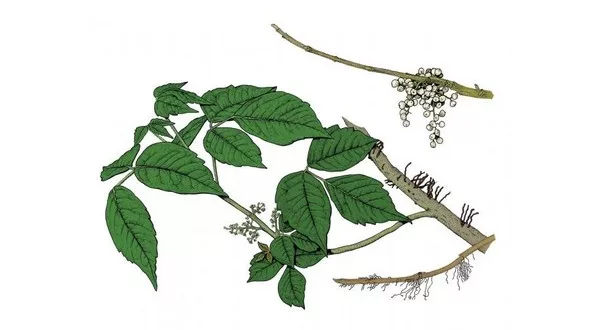
Image courtesy of Missouri Department of Conservation
As the Missouri Department of Conservation is encouraging area residents and tourists to get outside and discover nature, words of caution are also being given on plants that can be poisonous to humans.
The most common is poison ivy. According to the conservation department, it’s a toxic vine climbing to 60 feet high, trailing or climbing by aerial roots. Poison ivy sometimes appears as a low, upright shrub.
Leaves on poison ivy are alternate, compound, with three leaflets variable in size and shape. The center leaflet has a stalk anywhere from a half inch to 1 3/4 inches long and is longer than the stalks on the other two leaflets. Side leaflets have unequal sides. Leaflets take on different textures and hues as the season progresses. They turn red, orange or yellow in fall.
Stems on poison ivy are light brown and hairy with raised pores, climbing by aerial rootlets. Stems trail until they find support. When lacking support, they assume an erect, shrub-like posture with single stems.
Flowers on the plants start appearing anytime between May and June with clusters 1-to4 inches long on new growth of stems. Flowers are small, greenish white and fragrant. Then, between August and November, fruit ripens with berries in grapelike clusters, nearly a quarter-inch across. The fruit is normally creamy white, waxy, globe-shaped and usually smooth.
Eastern poison oak is a closely-related species occurring in low-nutrient, sandy or rocky soils, including glades, openings of dry upland forests, sand prairies, sand savannas and roadsides. It’s uncommon but limited to the southern part of the Missouri Ozarks and the northern part of the Bootheel Lowlands. Poison oak does not climb or produce aerial roots, and its leaflets usually have three to seven deep, relatively rounded lobes. The leaflets resemble the leaves of white or blackjack oak, and the berry-like fruits have inconspicuous hairs.
Another plant is known as poison sumac. Although some have used that name for Missouri species, poison sumac technically belongs to a plant that does not occur in Missouri. True poison sumac has feather-compound leaves with seven to 13 leaflets. It occurs in swamps and bogs to the east and north of our state.
Missouri has three other plants often mistaken for poison ivy. Fragrant sumac has three-parted leaves, but the terminal leaflet lacks the distinct stalk found in poison ivy, and the berries are reddish and fuzzy. Box elder has leaves with three to seven leaflets, but the leaves are opposite on the stem instead of alternate as in poison ivy. Virginia creeper climbs like poison ivy, but it usually has five leaflets instead of three, and it has blue berries.
For more information on poison ivy and other items to discover in Missouri nature, visit mdc.mo.gov/discover-nature.
WebReadyTM Powered by WireReady® NSI










